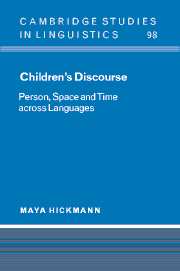Book contents
- Frontmatter
- Contents
- List of figures
- List of tables
- Preface
- List of abbreviations and conventions
- 1 Introduction
- Part I AVAILABLE THEORIES AND DATA
- 2 Theoretical issues
- 3 Cross-linguistic invariants and variations
- 4 Coherence and cohesion in discourse development
- 5 Children's marking of information status: referring expressions and clause structure
- 6 The acquisition of spatial and temporal-aspectual devices
- Part II A CROSS-LINGUISTIC STUDY OF CHILDREN'S NARRATIVES
- Appendix
- Notes
- References
- Author index
- Subject index
5 - Children's marking of information status: referring expressions and clause structure
from Part I - AVAILABLE THEORIES AND DATA
Published online by Cambridge University Press: 22 September 2009
- Frontmatter
- Contents
- List of figures
- List of tables
- Preface
- List of abbreviations and conventions
- 1 Introduction
- Part I AVAILABLE THEORIES AND DATA
- 2 Theoretical issues
- 3 Cross-linguistic invariants and variations
- 4 Coherence and cohesion in discourse development
- 5 Children's marking of information status: referring expressions and clause structure
- 6 The acquisition of spatial and temporal-aspectual devices
- Part II A CROSS-LINGUISTIC STUDY OF CHILDREN'S NARRATIVES
- Appendix
- Notes
- References
- Author index
- Subject index
Summary
We now examine the questions raised by the preceding chapters in the light of the available research pertaining to children's acquisition of a variety of linguistic devices across several domains. The present chapter focuses on children's uses of referring expressions and of clause structure when denoting entities in discourse. Studies concerning referring expressions (Section 5.1) have focused on different syntactic, semantic, and pragmatic aspects of these devices, reaching strikingly divergent conclusions about the rhythm, course, and determinants of acquisition in this domain of child language. A review of this evidence suggests that, despite some early uses of different types of referring expressions, the discourse-internal cohesive functions of these devices constitute a late development. In addition, some scattered developmental evidence shows variable uses of clause structure across languages (Section 5.2), but little is still known about the functions of such linguistic devices in children's discourse development. In summary (Section 5.3), the proposed synthesis of this literature argues for the need to bring together different lines of research in order to determine the impact of sentence and discourse factors on development within a cross-linguistic perspective.
Referring expressions
A great number of studies have examined children's comprehension and production of referring expressions (nominal determiners, overt pronouns, null elements). A review of this literature shows a striking divergence in the conclusions reached by different authors with respect to the rhythm of development.
- Type
- Chapter
- Information
- Children's DiscoursePerson, Space and Time across Languages, pp. 108 - 140Publisher: Cambridge University PressPrint publication year: 2002



